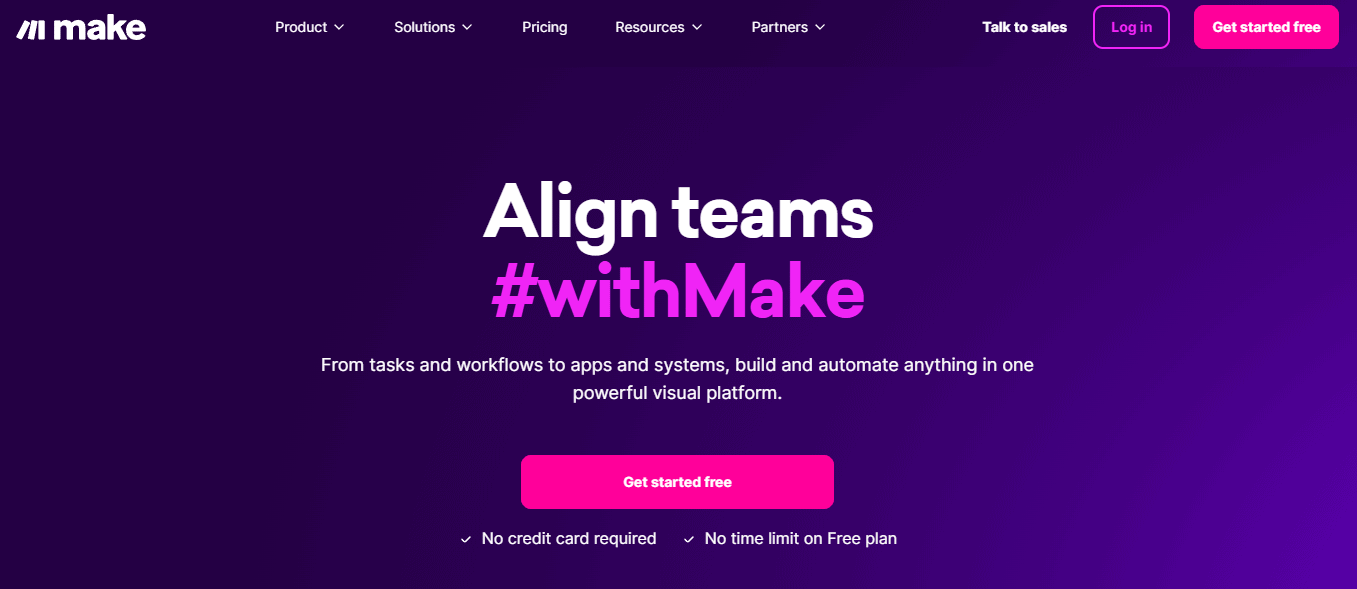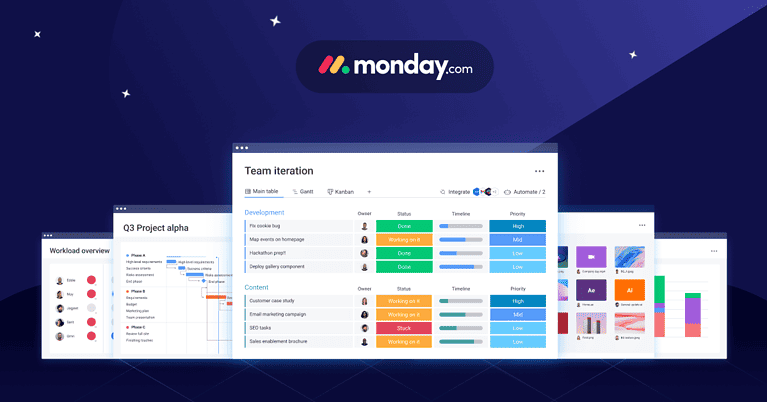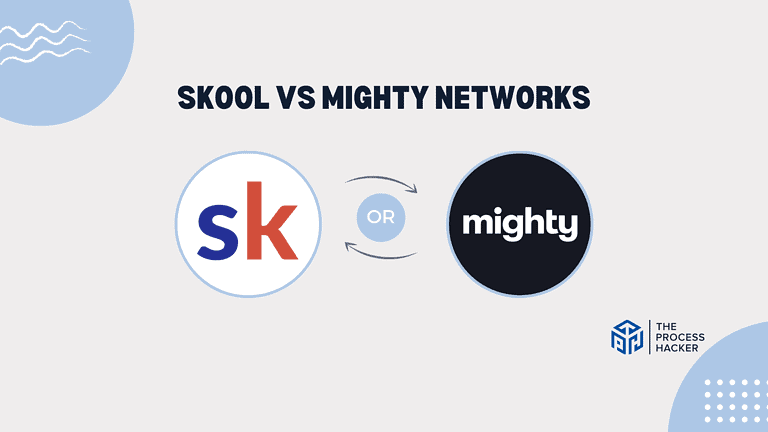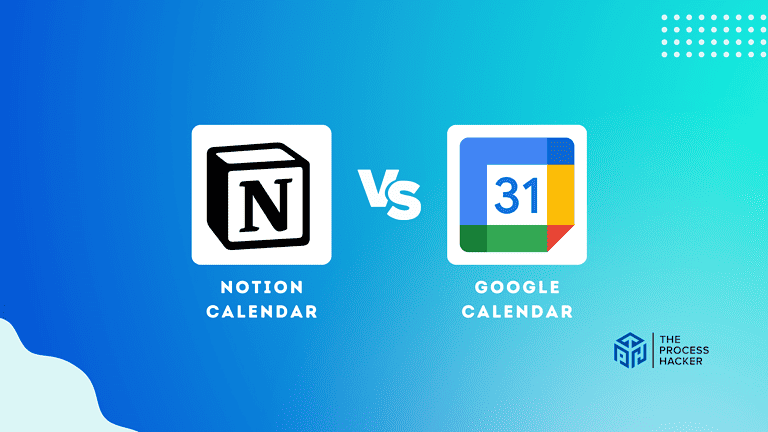Make Review 2024: One of the Best Automation Platforms to Automate Tasks and Workflows?
Make (formerly Integromat) is a name you’re likely hearing more and more these days, and for good reason. This platform is changing how businesses automate their work, offering a powerful and flexible solution to connect your favorite apps and streamline your workflows.
But with so many workflow automation tools on the market, like Zapier, n8n, and Tray.io, is Make genuinely the best choice for your needs? Or is it just one of many automation tools you should check out?
If you purchase through our partner links, we get paid for the referral at no additional cost to you! For more information, visit my disclosure page.
In this review, we’ll dive deep into Make’s features, explore its strengths and weaknesses, and help you decide if it fits your automation goals.

One Platform for All Task Automation Needs
Make is a powerful automation platform that allows you to connect different apps and services to automate simple and complex tasks and workflows. Think of it as a digital conductor that orchestrates all your favorite tools to work together seamlessly.
Make Pros & Cons
No tool is perfect, and Make is no exception. But weighing the good against the bad is essential to see if it fits your needs correctly.
Pros
Cons
Make Pros
- Incredibly versatile: With thousands of pre-built integrations and the ability to connect to virtually any app with an API, the possibilities with Make are endless. You can automate almost anything, from simple tasks like sending email notifications to complex workflows like managing your entire sales process.
- Visual workflow editor: Make’s drag-and-drop interface makes building and visualizing your automations easy, even if you have no coding experience.
- Powerful features: Make offers a wide range of features that give you much control over your automations. This includes features like data parsing, conditional logic, and scheduling.
Make Cons
- Support can be a bit hit-or-miss: While Make’s support team is generally helpful, their response times can be unpredictable. You might get a quick answer one day and then wait several days for a response to your following query. This can be a real pain when you’re in the middle of setting up a crucial automation.
- Connecting to certain apps can be a headache: You’ll find that connecting to most apps is a breeze, but things can get tricky when you need to create a webhook from scratch. This is especially true if the app you’re trying to connect to has poor custom API documentation, leaving you feeling lost and frustrated.
Quick Verdict – Is Make Worth the Money?
In a nutshell, yes! Make is a seriously powerful, versatile, and valuable tool that can save you a ton of time by automating tedious, repetitive tasks that bog you down. Imagine connecting all your favorite apps and having them seamlessly work together – that’s the magic of Make.
It’s incredibly user-friendly, even for those who aren’t tech-savvy. The drag-and-drop interface makes building automations a breeze. And with a massive library of pre-built integrations, you can connect to almost any app you can think of.
Now, no tool is perfect, and Make has some minor drawbacks. Support can be slow sometimes, and connecting to certain apps can be tricky if you need to create a webhook from scratch.
But overall, the pros far outweigh the cons. Make is a game-changer for anyone looking to streamline their workflows and boost their productivity. If you’re ready to put your work on autopilot, give Make a try.
Who is Make for?
You’ll love Make if:
- You’re an entrepreneur or small business owner looking to streamline operations: Make is perfect for automating those everyday tasks that take up so much of your time, like managing your email list, processing orders, or updating your social media on Google Sheets.
- You’re tired of repetitive tasks eating up your valuable time: Reclaim your day by letting Make handle the tedious stuff. You can automate anything from data entry to report generation, freeing you to focus on what matters most.
- You want to integrate multiple apps and services without coding knowledge: Make’s visual workflow editor makes it easy to connect your favorite apps and create powerful automations, even if you don’t know a single line of code.
You won’t love Make if:
- You’re looking for a simple, single-purpose automation tool: Make, which is designed for more complex automations. If you only need to automate a single task, there might be simpler tools out there that are a better fit.
- You’re not willing to invest time in learning a new platform: While Make is user-friendly, learning how to use all its features still takes time. It may be frustrating if you’re unwilling to put in the effort.
- You require enterprise-level features right out of the gate: Make is an excellent option for businesses of all sizes. However, if you need advanced features like custom SLAs or dedicated account management, you should look at a more enterprise-focused solution.
What is Make?
Make is a powerful automation platform that allows you to connect different apps and services to automate simple and complex tasks and workflows. Think of it as a digital conductor that orchestrates all your favorite tools to work together seamlessly.
What is the key benefit of having Make?
Make empowers you to create custom automated workflows, which translates to significant time savings and reduced errors across your business processes. Imagine offloading those repetitive, manual tasks to Make and freeing up your time to focus on more strategic initiatives.
How does Make work?
Make uses a visual, drag-and-drop interface to create what they call “scenarios” – essentially, automated workflows. You simply select the apps and services you want to connect and then use the intuitive interface to define the steps in your automation.
Here’s a quick overview of how it works:
- Connect your apps: Make offers a vast library of pre-built integrations with popular apps and services. You can also connect to virtually any app with an API.
- Build your scenarios: Use the drag-and-drop interface to create your automated workflows. You can define triggers, actions, and conditions to control the flow of your automation.
- Run your automations: Once you’ve built your scenario, you can trigger it manually, on a schedule, or based on specific events in your connected apps.
How is it different from competitors?
Make stands out from the crowd with its intuitive visual interface, extensive integration library, and flexible pricing options suitable for businesses of all sizes. It’s a versatile and powerful tool that can automate many tasks and workflows.
Reasons I Recommend Make to Everyone
Make has quickly become one of my go-to tools, and it has the potential to be a game-changer for many businesses. Here’s why I’m so impressed with this platform:
#1) Unparalleled Flexibility in Workflow Design
Make offers an incredible level of flexibility when it comes to designing your automations. You’re not limited to pre-built templates or rigid workflows. Instead, you have complete control over how your automations function.
Think of it like this: Make gives you the building blocks, and you can decide how to put them together. This means you can create automations that perfectly match your specific needs and workflows, no matter how unique or complex they may be.
This level of customization is what truly sets Make apart. It empowers you to automate tasks exactly how you want without being constrained by pre-defined limitations.
#2) Extensive Integration Capabilities
One of the things that genuinely sets Make apart is its massive library of integrations. You’ll find pre-built connections for a huge range of popular apps and services, making it easy to connect the tools you already use and love.
But it doesn’t stop there. Make also gives you the power to connect to virtually any app with an API, even if it’s not officially supported (although it’s not super easy). This opens up a whole world of possibilities for automating your workflows and connecting even the most niche tools in your tech stack.
Whether you’re working with marketing automation platforms, CRMs, e-commerce platforms, or even custom-built applications, Make has you covered. This extensive integration capability ensures that you can connect all the pieces of your digital puzzle and create truly seamless automated workflows.
#3) Scalability for Growing Businesses
Make is a platform that grows with you. Whether you’re a solopreneur just starting out or a rapidly scaling business with complex needs, Make can adapt to your changing requirements.
As your business grows and your automation needs evolve, Make provides the scalability to handle increased complexity and volume. You can easily add new integrations, expand your workflows, and manage more data without hitting any roadblocks.
Make’s flexible pricing plans also cater to businesses of all sizes. You can start with a free plan and then upgrade as your needs grow, ensuring you only pay for the features and resources you actually use. This makes Make a cost-effective solution for businesses at any stage of their growth journey.
What You Might Not Like about Make
While Make is a fantastic tool overall, there are a couple of things to be aware of that might not be ideal for everyone.
#1) Initial Learning Curve
I’ll be honest: while Make’s visual workflow editor is generally intuitive, getting the hang of some of the more advanced features took a bit of time and effort. There’s definitely a learning curve involved, especially if you’re new to automation platforms.
However, don’t let this discourage you! Make provides excellent documentation and a supportive community forum that can help you get up to speed quickly. I found these resources to be invaluable when I was first starting out.
#2) Limited Free Plan
Make offers a free plan, which is great for getting started and exploring the platform’s capabilities. However, it has some limitations, particularly regarding the number of operations you can perform.
Depending on your needs, you might hit these limits sooner than you’d like. In my case, I upgraded to a paid plan within a month to unlock more operations and features. While the paid plans are reasonably and competitively priced, it’s something to remember if you’re on a tight budget.
Make Pricing
Curious about what Make will cost you? They’ve got a plan for everyone, from individuals just starting out to large enterprises. If you’re simply dipping your toes into automation, the Free plan lets you experiment with their drag-and-drop interface and access over 2000 apps, but you’re limited to 1,000 operations per month.
Need more? The Core plan, at $10.59/month, gives you unlimited active scenarios and access to the Make API. For those who crave more advanced features like custom variables and priority execution, the Pro plan is your best bet at $18.82/month.
Got a whole team automating workflows? The Teams plan, priced at $34.12/month, adds collaboration features and high-priority customer support. And for the big players with complex needs, Make offers customized Enterprise solutions – just reach out to their sales team for a quote. Make has a pricing plan that fits, no matter your budget or automation goals.
Make: Key Features Breakdown
Visual Workflow Builder
At the heart of Make lies its intuitive visual workflow builder. This drag-and-drop interface allows you to create complex automations without writing a single line of code. You simply select the apps you want to connect and then visually map out the steps in your workflow.
Think of it as a building with digital Lego blocks. You drag and drop different “modules” representing actions, triggers, and conditions and then connect them to create your desired automation flow. This visual approach makes it incredibly easy to understand and manage even the most complex automations.
The visual workflow builder is a game-changer for those who are new to the automation journey or prefer a more visual approach to problem-solving. It takes the complexity out of building automations and empowers you to easily create powerful workflows.
Extensive App Integrations
Make boasts a massive library of pre-built integrations with popular apps and services. You’ll find everything from marketing automation platforms and CRMs to e-commerce solutions and project management tools. This means you can easily connect the tools you already use and love and create seamless workflows between them.
But Make goes beyond just pre-built integrations. It also allows you to connect to virtually any app with an API, even if it still needs to be officially supported, although some would be a bit hard. This opens up a world of possibilities for automating your workflows and integrating even the most niche tools in your tech stack.
Whether you’re looking to connect your email marketing platform to your CRM or your e-commerce store to your accounting software, Make has you covered. This extensive integration capability ensures you can create comprehensive automations that span your entire business.
Data Mapping and Transformation
Make doesn’t just shuffle data between apps; it gives you the power to manipulate and transform that data along the way. This means you can clean, format, and enrich your data as it moves through your automated workflows.
Need to extract specific information from a block of text? Make has you covered. Want to convert data from one format to another? No problem. You can even perform calculations and apply conditional logic to your data to ensure it’s always in the format you need.
This data mapping and transformation capability is essential for creating truly efficient and reliable automations. It ensures that your data is always consistent and ready for use by the next app in your workflow, eliminating manual data cleaning and formatting tasks.
Error Handling and Logging
Things don’t always go as planned, and that’s true for automations as well. But Make has you covered with robust error handling and logging capabilities for you. If an error occurs during your automation, Make will not only notify you but also provide detailed logs to help you identify and troubleshoot the issue.
You can configure Make to handle errors in different ways, such as retrying the failed step, sending you an email notification, or even triggering a separate workflow to address the issue. This level of control allows you to build resilient automations that can gracefully handle unexpected situations.
The detailed error logs provide valuable insights into what went wrong, including the specific step that failed, the data that was being processed, and any relevant error messages. This information makes it much easier to pinpoint the root cause of the problem and quickly resolve it.
FAQs about Make
Here are some of the most frequently asked questions about this powerful automation platform:
What kind of apps can I connect with Make?
Make offers a vast library of pre-built integrations with popular apps and services, including marketing automation platforms, CRMs, e-commerce solutions, social media platforms, and much more. You can also connect to virtually any app with an API, even if it’s not officially supported.
Is Make challenging to learn?
Make’s visual workflow builder is designed to be intuitive and user-friendly, even for those who are new to automation. While there is a learning curve involved in mastering some of the more advanced features, Make provides excellent documentation and a supportive community forum to help you get up to speed quickly.
What happens if my automation encounters an error?
Make has robust error handling capabilities. Make will notify you if an error occurs and provide detailed logs to help you troubleshoot the issue. You can also configure Make to automatically retry failed steps, send email notifications, or even trigger separate workflows to address the error.
What if I need help building my automations?
Make offers a variety of support resources, including comprehensive documentation, a helpful community forum, and email support. For those who need more hands-on assistance, Make also offers professional services, where their experts can help you design, build, and implement your automations.
Final Verdict – to Get Make or Not to Get Make?

One Platform for All Task Automation Needs
Make is a powerful automation platform that allows you to connect different apps and services to automate simple and complex tasks and workflows. Think of it as a digital conductor that orchestrates all your favorite tools to work together seamlessly.
So, is Make one of the best automation platforms to automate tasks and workflows?
Make has genuinely impressed me with its versatility, user-friendliness, and extensive integration capabilities. It’s a platform that empowers you to take control of your workflows and automate tasks in a way that feels intuitive and even enjoyable.
Whether you’re a small business owner looking to streamline your operations, a busy professional seeking to reclaim valuable time, or a tech-savvy individual wanting to build complex automations, Make has something to offer.
While there’s a slight learning curve involved, especially when you delve into the more advanced features, the time you invest will pay dividends in the long run. And with a range of pricing plans to suit different needs and budgets, Make is accessible to businesses of all sizes.
If you’re ready to embrace the power of automation and unlock new levels of productivity, I highly recommend giving Make a try.
Get started today with a free plan to explore its capabilities and see firsthand how it can transform your work!
Make Alternatives
While Make is a fantastic automation platform, exploring other options to see what else is out there is always good. Here are other platforms worth considering:
#1) Zapier
Zapier is a popular name in the automation space, and it is known for its user-friendly interface and ease of use. If you’re looking for a platform that’s easy to get started with and requires minimal technical knowledge, Zapier is a solid choice.
However, compared to Make, Zapier has a more limited selection of integrations and lacks some of the advanced features and customization options that Make offers. It’s a good option for simpler automations, but Make might be a better fit if you need more flexibility and control.
#2) n8n
For those who prefer open-source solutions and have some technical expertise, n8n is a great alternative to consider. It offers high customization and control, allowing you to self-host your automation infrastructure and tailor it to your specific needs.
However, n8n requires more technical knowledge to set up and manage than Make’s user-friendly interface. It’s ideal for developers or tech-savvy users who are comfortable working with code and server infrastructure.
#3) Relay.app
Relay.app is another no-code automation platform that enables users to integrate various applications and automate workflows. It incorporates AI capabilities and human-in-the-loop features that seamlessly integrate human decision-making within automated processes.
In contrast, Make.com offers a visual scenario editor optimized for fully automated flows, which can be challenging when incorporating human input. Even though it is more expensive, Relay.app has a user-friendly interface and exceptional customer support.







